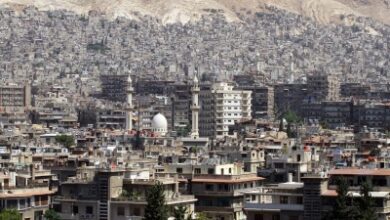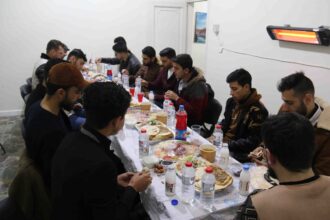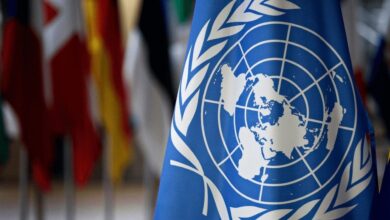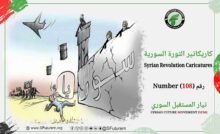Media OfficeSymbols and Figures of the State in Syria
Symbols and Figures of the State in Syria (7): Taj al-Din al-Hasani
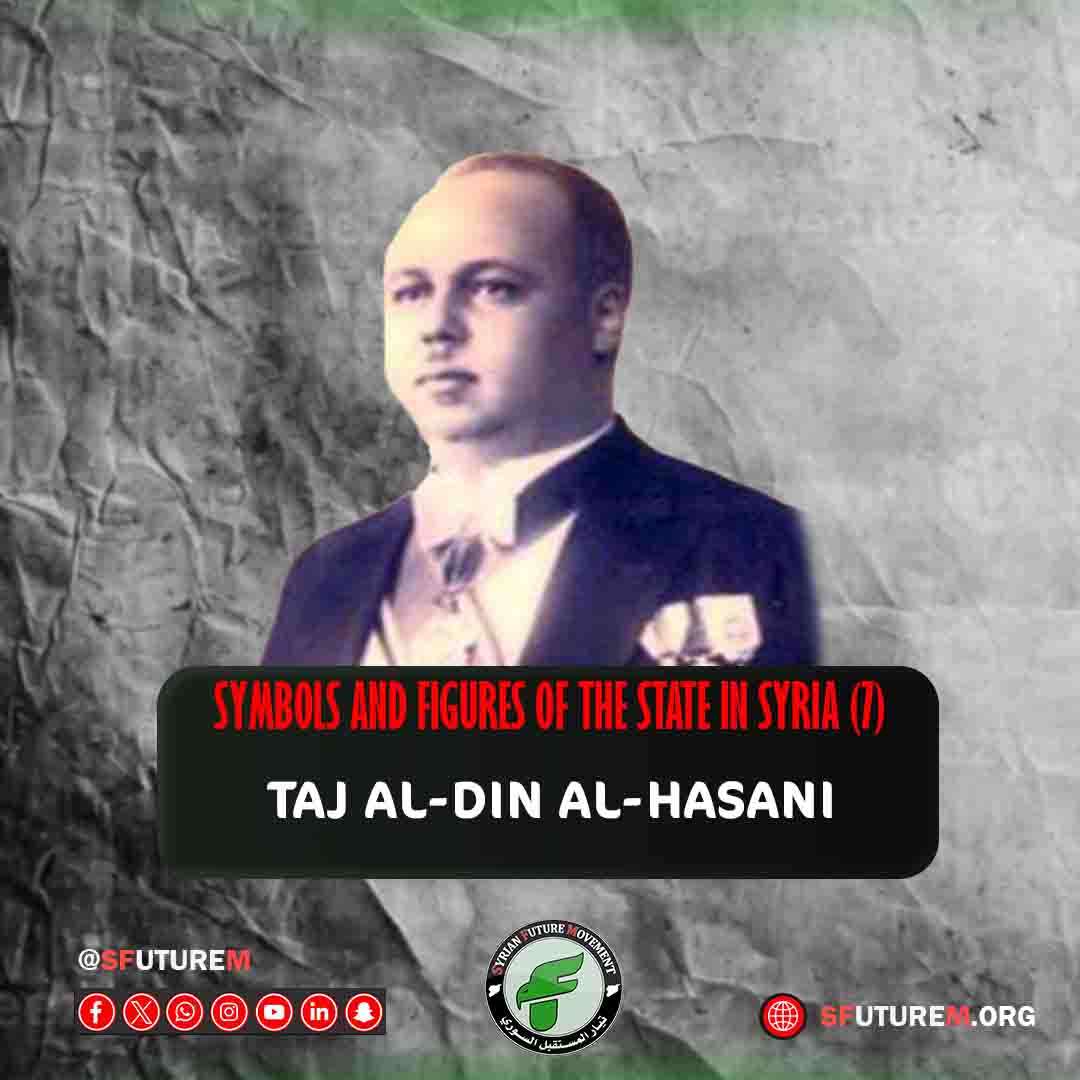
- Taj al-Din al-Hasani was born in Damascus and studied Sharia sciences and the Arabic language under his father, Sheikh Badr al-Din al-Hasani, one of the most famous scholars of his time in the Levant.
- He studied Islamic jurisprudence under Sheikh Muhammad Rashid al-Attar.
- In 191m, he was appointed a teacher at the Sultanate School in Damascus and a member of the School Reform Council.
- Jamal Pasha, the military ruler of Syria during World War I, chose him to be the editor-in-chief of the Al-Sharq newspaper, which was established by the Ottoman state in Syria.
- He collaborated with the nationalist thinker Shakib Arslan, who became the deputy editor-in-chief.
- The first issue of Al-Sharq newspaper was published on April 27, 1916.
- After Prince Shakib resigned from his position in protest against Jamal Pasha’s execution of a group of Arab leaders in Damascus and Beirut, Sheikh Taj tasked his journalist friend Muhammad Kurd Ali with managing the newspaper, which continued to be published until the Ottomans left Syria on September 26, 1918.
- Al-Hasani was one of the representatives of Damascus at the Syrian General Conference in 1919, which called for the independence of Syria (from Antioch to Gaza) under the rule of Prince Faisal bin Al-Hussein.
- He pledged allegiance to Prince Faisal as the ruler of Damascus on October 3, 1918, and placed himself at the disposal of his father, Sharif Hussein bin Ali, the leader of the Arab Revolt against the Ottoman state.
- Prince Faisal appointed him director of the royal palace in the Al-Muhajireen area, at the foot of Mount Qasioun.
- Sheikh Taj was named a member of the Sharia Court of Cassation and the Syrian Advisory Council.
- During the Faisal period (1918-1920), he joined the Syrian National Party, founded by Emir Haj Abd al-Rahman Pasha al-Yusuf, advocating for the unity and complete independence of Syrian lands from any European domination.
- In 1919, he ran in the parliamentary elections held in Syria and won a seat representing Damascus at the Syrian General Conference, the first legislative authority in modern Syrian history.
- He participated in the coronation ceremony of Prince Faisal as king of the country on March 8, 1920.
- He left Syria after King Faisal was deposed in the summer of 1920, following a military confrontation with the French army at the Battle of Maysalun on July 24, 1920, and traveled to France, where he met most of the influential figures of the Mandate who requested him to return to Damascus and form a national unity government in the early days of the Great Syrian Revolution, succeeding President Subhi Barakat’s government.
- He refused the French request due to the political tension and the outbreak of armed revolution throughout the country.
- A few months after the end of the revolution, he was assigned for a second time and accepted the task, forming his first government on February 15, 1928.
- The government was composed of only six ministers, all of whom were dignitaries.
- This ministry was tasked with overseeing the general elections for the Constituent Assembly, which was supposed to draft Syria’s first republican constitution that met national demands.
- The elections were held on April 24, 1928, where Sheikh Taj managed to put his name on all the electoral lists in Damascus, including the National Bloc’s list, and he became known as “Sheikh of the Lists.”
- Out of nine deputies for Damascus, the National Bloc won eight seats, and the ninth seat went to Sheikh Taj himself.
- The elected committee held its first meetings on June 9, 1928, and began working on drafting the new constitution under the supervision of Hashim al-Atassi, the president of the conference, representing the National Bloc. They drafted a modern constitution within two weeks, without any mention of the French Mandate.
- The French High Commission in Beirut was outraged and requested amendments to six articles of the constitution, but Hashim al-Atassi refused. France objected to granting the Syrian President, instead of the French High Commissioner, the right to conclude international treaties and declare peace and war, and demanded constitutional recognition of the mandate.
- At that time, Sheikh Taj proposed accepting the French amendments to avoid any clash with the Mandate authority, which led to an attack by Damascus deputy Fakhri al-Baroudi, forcing him to leave the conference in protest and anger.
- Subsequently, with the insistence of the nationalists on their position, France dissolved the Constituent Assembly and suspended the constitution indefinitely.
- On August 14, 1930, Sheikh Taj made a slight amendment to his government, after dismissing some ministers defeated in the elections, taking over the Ministry of the Interior himself, replacing Said Mohsen, and appointing the eminent legal scholar Shaker al-Hanbali as Minister of Justice, replacing Subhi Niyal. He also transferred Tawfiq Shamieh from the Ministry of Public Works to the Ministry of Finance, appointing the independent Fuad al-Adli as Minister of Public Works, but retained both Muhammad Kurd Ali and Abdul Qadir al-Kilani in their positions.
- On October 27, 1930, he dismissed al-Kilani and named the former President of the Advisory Council Badi’ Moayyad al-Azm as Minister of Agriculture in his third government.
- Sheikh Taj was very proud of the infrastructural achievements of his government and requested the government printing press to publish a book about them, which was published in Damascus in 1931.
- These achievements included the establishment of Ibn Rushd Hospital for infectious diseases in Aleppo and Al-Razi Hospital for dermatology and ophthalmology, in addition to the Mental Hospital in Al-Qusayr and another hospital in Deir ez-Zor.
- During his tenure, 24 schools for boys, four schools for girls, and three schools for Bedouins were inaugurated, along with the Higher School of Arts in Damascus, which he opened on November 9, 1929.
- The achievements also included the construction of the Damascus-Aleppo road, the Quneitra-Banias road, and the establishment of government buildings in Aleppo (in the Friday Market opposite the Citadel), Idlib, Qamishli, Ras al-Ain, Afrin, Al-Bab, Manbij, and Jarabulus in the north, as well as Qatana and Douma in the Damascus countryside. Finally, the modern parliamentary building in Damascus, which was built on the ruins of an old cinema.
- He ran for parliamentary elections in 1932 and won his usual seat representing Damascus.
- He also ran for the first presidential elections in Syria. He contested the election battle within the parliament against Hashim al-Atassi, representing the National Bloc, former Prime Minister Ali Rida al-Rikabi, representing the Royal Ummah Party, Haqqi al-Azm, former President of the State of Damascus, representing the pro-French faction, former President of the Syrian Union State Subhi Barakat, representing the northern forces, and the independent candidate Muhammad Ali al-Abed, former Ottoman ambassador in Washington.
- Al-Abed won the first presidency on June 11, 1932, and Sheikh Taj disappeared from the scene again until 1934 when the President of the Republic requested him to form the new Syrian government, succeeding the government of President Haqqi al-Azm.
- Sheikh Taj’s policy changed, and he did not rely on any of his traditional allies except for his loyal friend Jamil al-Ulshi, who was appointed Minister of Public Works. The rest of the portfolios went to figures associated with the nationalist faction, which had previously been highly critical of Sheikh Taj, constantly accusing him of appeasing the French and being a collaborator.
- He brought in one of the pillars of the National Bloc, Hasni al-Barazi, as Minister of Education and appointed Ata al-Ayoubi, a close associate of Hashim al-Atassi, as Minister of Justice. However, this government faced significant public backlash upon the death of Aleppo leader and northern revolution leader Ibrahim Hanano in November 1935.
- Most political forces took part in his funeral and chanted slogans against the Prime Minister and the Mandate regime. France responded by arresting the demonstrators and imprisoning them, which sparked larger and wider demonstrations in all Syrian cities. Sheikh Taj tried to contain the situation to no avail, and the demonstrations turned into a general strike known as the “Sixty-Day Strike.”
- After the French arrested Damascus deputy Fakhri al-Baroudi, one of the National Bloc’s pillars, France eventually abandoned Sheikh Taj to appease the public and agreed to appoint a new Prime Minister acceptable to the Bloc’s leaders, Ata al-Ayoubi, on February 24, 1934.
- In 1941, the country was suffering from violent disturbances due to World War II and the entry of Free French forces into Syria to liberate it from the Vichy regime aligned with Nazi Germany. French resistance leader General Charles de Gaulle came to Damascus and promised the Syrian people independence, but insisted on the continued presence of the French army in Syria until the end of the war in Europe. Hashim al-Atassi was invited to return to the presidency, but he refused, saying: “The French have broken their promises in the past!” So the choice fell on Sheikh Taj to be President of Syria, on the condition that he govern without a parliament or constitution until the battles in Europe ended.
- Sheikh Taj had spent the war years in Paris and returned to Damascus under Vichy rule, where his movements raised suspicions and concerns among pro-German officials, who placed him under house arrest in his palace in the Al-Halbouni area.
- The ban was lifted with the arrival of General Charles de Gaulle in Syria in 1941, who held lengthy meetings with Sheikh Taj and asked him to reach an agreement with the National Bloc leaders to legitimize his new rule.
- Sheikh Taj agreed and offered yesterday’s opponent Jamil Mardam Bey to be Prime Minister during his term, but this agreement failed due to Hashim al-Atassi’s opposition.
- Sheikh Taj conditioned the French on unifying the Syrian territories under his presidency and incorporating both the State of the Alawites and the State of the Druze into the Syrian Republic.
- In his response to the French, Sheikh Taj said: “As an appointed president, not an elected one, you can remove me with a single stroke of the pen. Therefore, I would like to be officially invited to assume the reins of power, just as the British government invited King Faisal I to assume the throne of Iraq.” Indeed, Charles de Gaulle agreed to his request and sent a formal letter to Sheikh Taj, inviting him to assume the presidency on September 12, 1941.
- The letter began by addressing Sheikh Taj as “His Excellency the President” since he was a former Prime Minister and ended with the phrase: “With utmost respect, Your Excellency the President.”
- To gain added legitimacy, Sheikh Taj asked Hassan al-Hakim, one of the most honest and experienced Syrian politicians in managing state affairs, to be the first Prime Minister during his term. Hassan al-Hakim was a friend and ally of the late doctor Abdul Rahman al-Shahbandar, one of the leaders of the national struggle in Syria, who was assassinated in 1940.
- Sheikh Taj collaborated with him and with the Abdul Rahman al-Shahbandar faction, bringing in one of its symbols, lawyer Zaki al-Khatib, as Minister of Justice. He also collaborated with some members of the National Bloc, appointing four of its symbols to governmental positions.
- Sheikh Taj cooperated with minorities and invited them to take governmental positions during his term for the first time in Syrian history.
- He appointed Munir al-Abbas from the Alawite community as Minister of Public Works and tasked Abdul Ghafar Pasha al-Atrash from the Druze community with the Ministry of Defense; he was one of the leaders of the Great Syrian Revolution.
- On January 12, 1942, a grand ceremony was held at the government palace to celebrate the annexation of the two mountains to Syria, and a postage stamp was issued on this occasion bearing Sheikh Taj’s image. Afterward, Foreign Minister Fayez al-Khoury sent telegrams to the capitals of the world, announcing Syria’s independence from the French Mandate in the name of President Taj al-Din al-Hasani.
- Official responses came from kings and presidents worldwide, conferring international legitimacy on the new regime and its president.
- President Taj al-Din al-Hasani’s relationship with his Prime Minister Hassan al-Hakim began to deteriorate due to the latter’s insistence on reopening the investigation into the assassination of Dr. Abdul Rahman al-Shahbandar, which Sheikh Taj refused to avoid embarrassing the French authorities in Syria.
- Hassan al-Hakim resigned from his position, and Sheikh Taj appointed one of the National Bloc leaders, Hasni al-Barazi, to form the government. However, it also did not last long due to a conflict between al-Barazi and the President over the powers of the Prime Minister.
- After al-Barazi resigned on January 8, 1943, the choice fell on Jamil al-Ulshi, an old friend of Sheikh Taj al-Din al-Hasani, who had participated with him in all his previous governments and was the Prime Minister at the beginning of the French era.
- The government did not last long due to the President’s death just nine days after its formation on January 17, 1943.
- Damascus bid farewell to President Taj al-Din al-Hasani with an official and popular funeral attended by Lebanese President Emil Eddé, along with several Iraqi, Saudi, and Jordanian leaders.
- He was buried in the Bab al-Saghir cemetery, and it was said that he had suffered from blood poisoning, diagnosed by Lebanese doctors who had come from Beirut.
- Jamil al-Ulshi assumed the presidency on an acting basis until March 1943.
- Presidential elections were held in the summer of that year, bringing Shukri al-Quwatli to the presidency, succeeding Sheikh Taj al-Din al-Hasani.
We, in the Syrian Future Movement (SFM), as we remember the founding figures of the Syrian state, we recall one of the independence figures and one of the symbols of the first Syrian state, President Sheikh Taj al-Din al-Hasani, in a series of files we present to you to include the symbols and figures of the Syrian state, in our desire to connect our contemporary revolutionary present with a solid past and historical milestones, hoping to revive in our people the need to build and create men of state par excellence, to preserve the nation, protect the gains, and restore the pride and glory of the Syrian state after years of oppression, tyranny, and corruption.
